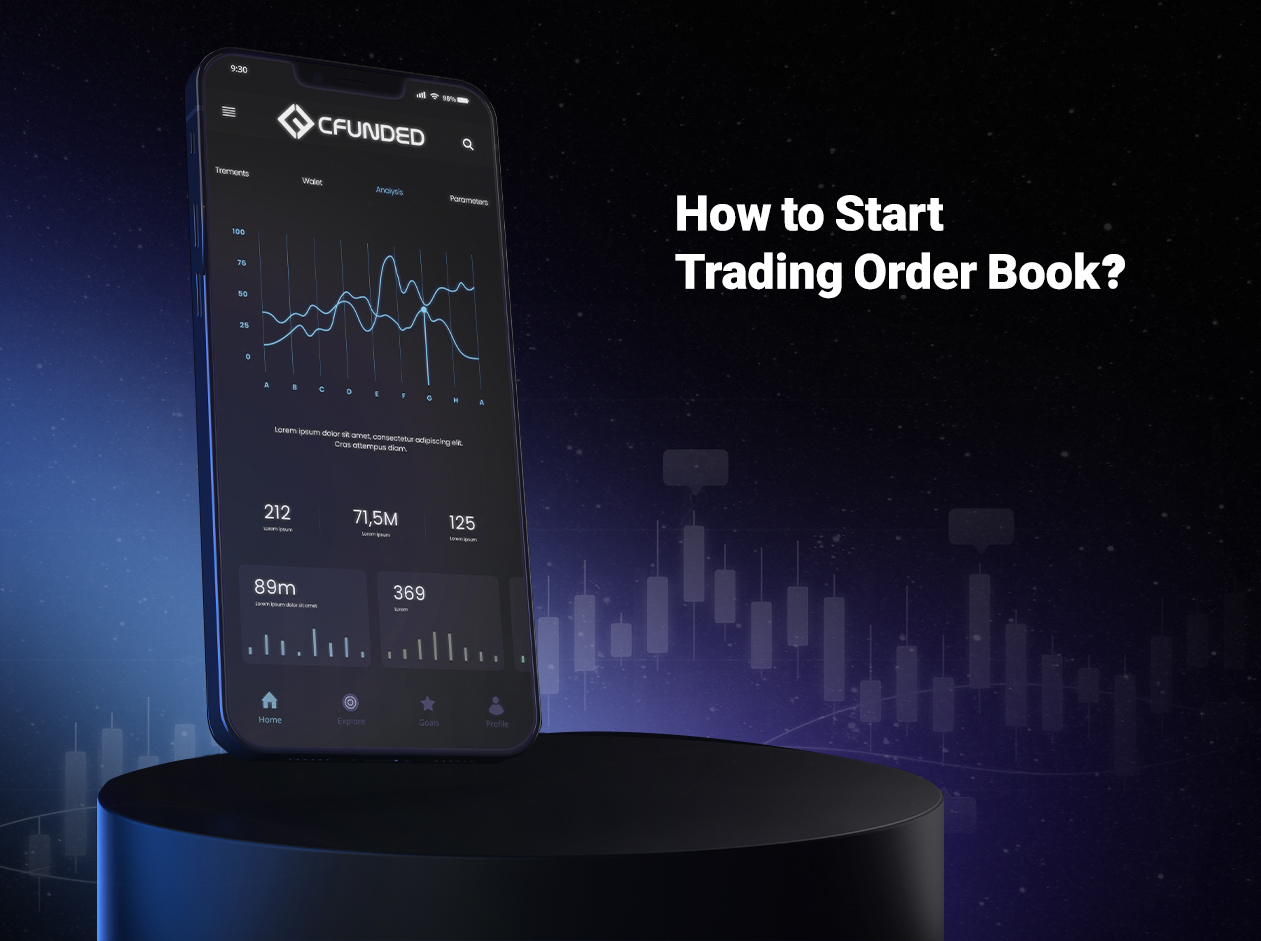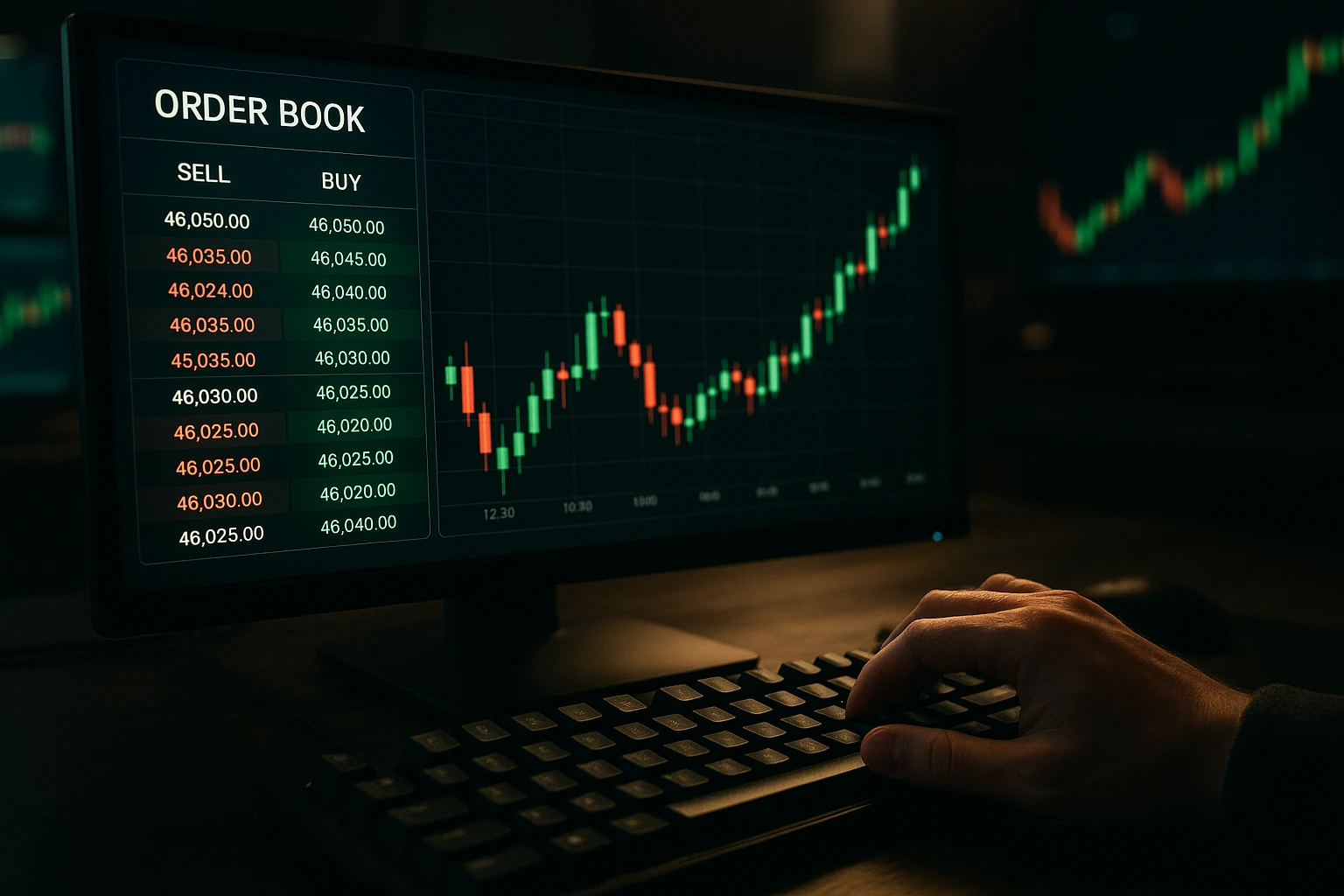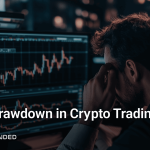Imagine being able to see the intentions of every buyer and seller in the market—before a single trade is executed. What if you could watch supply and demand unfold in real time, identify where large players are placing their bets, and anticipate price movements with greater confidence? This is exactly what the order book allows you to do.
In the world of modern trading, where speed, precision, and insight are everything, the order book stands out as one of the most powerful tools at your disposal. It is the real-time map of market activity, revealing not just prices, but pressure points—where the market hesitates, accelerates, or reverses.
Whether you’re trading Bitcoin, stocks, or foreign currencies, understanding the order book gives you a tactical advantage. It helps you recognize patterns, gauge liquidity, and make smarter, faster decisions.
Yet despite its power, the order book is often misunderstood or overlooked—especially by beginners. In this guide, we’ll demystify it. You’ll discover what the order book is, how it works, why it matters, and how to use it to elevate your trading game.
What Is an Order Book?
An order book is a real-time, electronic record that systematically displays all active buy and sell orders for a specific financial asset—such as a stock, cryptocurrency, currency pair, or commodity—on a trading platform. It provides a detailed view of market depth, showing exactly how much of an asset buyers are willing to purchase (bids) and how much sellers are willing to offer (asks) at various price levels.
This live data structure updates continuously as new orders are placed, executed, modified, or canceled, making it a crucial source of insight into the dynamics of supply and demand. An order book essentially acts as the heartbeat of any financial market, reflecting real-time trader behavior, sentiment shifts, and liquidity flows.
Order books are used across both centralized exchanges (CEXs) and decentralized exchanges (DEXs) to facilitate transparent trading. On centralized platforms, they are managed by the exchange itself, while on decentralized networks, smart contracts or peer-to-peer protocols manage the data.
By aggregating all visible limit orders in one place, the order book enables price discovery—the process by which the market determines the fair value of an asset based on current demand and supply. Traders, analysts, and algorithmic systems rely on the order book to assess volatility, predict potential price movement, and identify optimal entry and exit points.
In summary, an order book is not just a list of prices—it is a powerful tool for real-time market analysis, decision-making, and trade execution in modern electronic trading environments.
How It Works
The order book functions as the heart of electronic trading systems. It acts as a real-time matching engine, seamlessly connecting buyers and sellers through a fully automated, rule-based mechanism. Every order submitted by a trader—whether a buy or a sell—is entered into the order book, where it waits to be matched with an opposing order.
Here’s how the process works:
-
Order Placement: Traders place buy (bid) or sell (ask) orders by specifying both price and quantity. These are called limit orders unless designated as market orders.
-
Order Queuing: Once placed, orders are sorted within the order book. Sorting is done based on:
-
Price Priority: Higher bids (buyers willing to pay more) and lower asks (sellers willing to accept less) take precedence.
-
Time Priority: Among orders at the same price, those placed earlier are prioritized—this is known as the price-time priority rule.
-
-
Trade Execution: When the highest bid price matches the lowest ask price, a trade is automatically executed. The matched orders are either:
-
Fully removed, if the entire order quantity is filled; or
-
Partially filled, if only a portion of the quantity is executed, leaving the remaining volume in the book.
-
This efficient, rules-based structure ensures fast, fair, and transparent market activity.
Reading an Order Book
A typical order book is structured into two sides:
-
Left Side (Bids): Lists all active buy orders from highest to lowest price.
-
Right Side (Asks): Lists all active sell orders from lowest to highest price.
Each entry includes the following:
-
Bid Prices: The maximum prices buyers are willing to pay.
-
Ask Prices: The minimum prices sellers are willing to accept.
-
Volume: The quantity of the asset available at each price point.
-
Cumulative Volume: The aggregated total volume at or above/below a given price level.
The spread—the difference between the best (highest) bid and best (lowest) ask—is a key indicator of market liquidity. A tight spread suggests a highly liquid market, while a wide spread may indicate volatility or low participation.
Special Considerations
Despite its clarity and usefulness, the order book is not without limitations. Traders should be aware of certain dynamics that can skew or obscure true market intentions:
-
Spoofing & Fake Orders: Some participants intentionally place large, visible orders to deceive others, only to cancel them before execution. This manipulative tactic can give a false sense of demand or supply.
-
Slippage: In fast-moving or illiquid markets, your order might get filled at a worse price than expected—this is known as slippage.
-
Whale Activity: Large institutional traders, often referred to as “whales,” can impact market perception by placing or removing large orders, creating false signals.
-
Lack of Context: The order book shows what is being offered—but not why. You cannot see hidden orders, trader intent, or off-book transactions such as OTC deals.
Being aware of these nuances is key to interpreting the order book more accurately and protecting your trades from manipulation or poor execution.
Example
Let’s look at a simplified example of an order book for Bitcoin (BTC):
| Bid (Buy) | Volume | Ask (Sell) | Volume |
|---|---|---|---|
| $29,800 | 1.5 BTC | $30,000 | 1.2 BTC |
| $29,700 | 2.0 BTC | $30,100 | 0.9 BTC |
| $29,600 | 1.0 BTC | $30,200 | 1.8 BTC |
In this example, the spread is $200. If a buyer submits a market buy order, it will be executed at the lowest available ask—$30,000—filling up to 1.2 BTC depending on the volume.
This interaction updates the book in real time, removing or adjusting the corresponding order(s) accordingly.
What Does the Order Book Do?
The order book plays a crucial role in modern markets, offering multiple benefits and insights:
✅ Enhances Market Transparency: By showing all visible buy and sell intentions, the order book demystifies supply and demand mechanics.
✅ Displays Real-Time Supply and Demand: Traders can see how interest shifts across price levels and time.
✅ Supports Technical Analysis and Forecasting: Depth, volume walls, and order flow patterns offer powerful indicators for short- and long-term strategies.
✅ Reveals Institutional Behavior: Large, layered, or recurring orders may signal activity from professional or institutional traders.
With these advantages, the order book becomes a vital instrument for price forecasting, execution planning, and overall market understanding.
For traders looking to apply their order book expertise in a professional setting, CFUNDED offers one of the most competitive environments through its crypto prop firm challenge. By analyzing real-time order flow and executing trades based on bid-ask dynamics, participants can showcase their skills and earn access to funded trading accounts. Whether you’re a scalper, swing trader, or order book strategist, CFUNDED’s challenge provides the perfect platform to prove your edge in the fast-paced world of crypto markets.
Key Components of the Order Book
To analyze the order book effectively, it’s essential to understand its key components:
-
Bids: Buy orders, ranked from highest to lowest price.
-
Asks: Sell orders, ranked from lowest to highest price.
-
Spread: The difference between the top bid and top ask.
-
Order Volume: The amount of asset available at each price level.
-
Cumulative Volume: Total volume available at and beyond a specific price point, often used to assess liquidity and depth.
These elements form the foundation of order book structure, allowing traders to spot pressure points and market balance.
How Does the Order Book Work?
1. The Core Function: Order Matching
At its core, the order book ensures fair and accurate order matching. It automatically pairs buy and sell orders when their price conditions align, allowing for fast and efficient trade execution.
2. Market Depth and Spread – Two Sides of the Same Coin
-
Market depth measures the number of orders and total volume available at each level.
-
Spread reflects market liquidity and trading costs.
✅ Tight spread + high depth = liquid, stable market
❌ Wide spread + low depth = volatile, risky market
3. Price-Time Priority Rule
This rule governs which orders get filled first:
-
Best prices are prioritized.
-
Among orders with the same price, the earliest one is executed first.
This encourages competitive pricing and rewards timely action.
4. Real-Time Nature of the Order Book
Every update—whether it’s a new order, a cancellation, or a completed trade—is reflected immediately. Traders can monitor this flow to identify momentum, volume shifts, and potential breakouts.
Types of Order Books
Different exchanges and trading platforms may use one or more types of order books, each tailored to specific trading environments:
-
Limit Order Book: Displays only limit orders with defined prices.
-
Market Order Book: Includes incoming market orders in addition to existing limit orders.
-
Hybrid Order Book: Merges market and limit orders, typically used on advanced platforms.
-
Decentralized Order Book: Operates on blockchain-based platforms (DEXs) using smart contracts and peer-to-peer execution.
Each type influences execution style, speed, and visibility in unique ways.
How to Read and Analyze the Order Book
Here are practical techniques traders use to interpret the order book:
-
Volume Clusters: Large amounts of volume at a single price often signal support or resistance levels.
-
Order Flow Shifts: Tracking the increase or decrease of bids/asks helps identify momentum changes.
-
Imbalance Monitoring: A significant difference between total bid and ask volume can indicate bullish or bearish pressure.
-
Detecting Fake Orders: Sudden appearance and removal of large orders may indicate spoofing or manipulation.
Reading the order book well allows you to front-run inefficient moves, avoid traps, and manage your risk with greater accuracy.
Advantages and Disadvantages of the Order Book
✅ Advantages:
-
Real-time visibility into market demand and supply
-
Ideal for scalping, day trading, and algorithmic strategies
-
Helps detect breakout or reversal opportunities
-
Assists with managing slippage and order execution
❌ Disadvantages:
-
Vulnerable to manipulation via spoofing or iceberg orders
-
May overwhelm beginners due to constant updates
-
Does not show off-exchange (OTC) trades or hidden orders
-
Can be exploited by high-frequency trading (HFT) algorithms
Awareness of these pros and cons allows traders to approach the order book with a balanced strategy.
Order Book Trading Strategy
Here are several strategies built around order book analysis:
-
Scalping Tight Spreads: Capitalize on micro-price changes with quick entries and exits.
-
Order Imbalance Strategy: Trade in the direction of dominant volume flow—buy when bids outpace asks, and vice versa.
-
Spoof Detection: Recognize manipulative patterns (e.g., canceled large orders) and avoid false breakouts.
-
Liquidity Gap Plays: Target low-volume zones that are vulnerable to price spikes.
-
Fading Large Walls: Short against large, immovable-looking orders that may not represent real intention.
Effective use of these strategies depends on real-time observation, speed, and disciplined risk management.
Order Book on TradingView
TradingView is one of the most widely used charting platforms and integrates order book data with many top-tier exchanges. Features include:
-
Real-Time Depth Charts: Graphical representation of bid and ask volume.
-
DOM (Depth of Market): A granular view of every order level.
-
Order Flow Indicators: Visual tools to assess trading pressure and direction.
-
Live Trading Panels: Place or manage trades directly from the order book interface.
For scalpers and intraday traders, TradingView provides the data speed and visualization necessary to act with confidence.
Conclusion
The order book is more than just a list of trades—it’s a live map of the market’s psychology. It exposes liquidity zones, volume patterns, and the constant push-and-pull between buyers and sellers. By learning how to read and analyze it, traders can sharpen their edge, anticipate moves more accurately, and improve both timing and execution.
Whether you’re trading crypto, equities, forex, or futures, mastering the order book will elevate your strategy and bring greater clarity to the ever-evolving financial markets.




